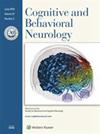亨廷顿病的病感失认和记忆编码
IF 1.3
4区 医学
Q4 BEHAVIORAL SCIENCES
引用次数: 1
摘要
背景:在亨廷顿舞蹈症(HD)患者中,认知障碍可表现为对神经行为症状的不了解。嗅觉缺失的测量具有挑战性,但嗅觉缺失量表(AS)是一个简短的选择,在小样本中有很好的发现。目的:在比以往研究更大的HD样本中复制AS的应用,以评估心理测量学和人口学相关性,并研究HD患者AS的遗传、运动和神经心理学相关性。方法:我们回顾性地回顾了74名遗传确认的亨廷顿舞蹈症基因携带者的AS评分,这些携带者几乎都是早期运动表现,他们被转诊进行临床神经心理评估。在可用的情况下,同时汇编临床神经检查和神经计量评估数据(n=35-74)。根据AS评分对HD样本的嗅觉缺失严重程度进行了表征。结果:AS评分与人口统计学变量、遗传标志物或运动功能障碍严重程度无关。相关分析显示,较高的AS评分与较差的识别-辨别记忆表现相关(r=0.38,P<0.05),但与执行功能表现或附带报告的额叶行为症状的认知控制无关。较高的AS评分也与较少的患者报告的抑郁症状(r=-0.38,P<0.01)和昼夜嗜睡症状(r=0.44,P<0.01)相关,尽管没有遗传或运动标志物的HD严重程度,也没有执行功能障碍或附带报告的额叶行为症状。本文章由计算机程序翻译,如有差异,请以英文原文为准。
Anosognosia and Memory Encoding in Huntington Disease
Background: Anosognosia can manifest as an unawareness of neurobehavioral symptoms in individuals with Huntington disease (HD). Measurement of anosognosia is challenging, but the Anosognosia Scale (AS) represents a brief option with promising findings in small samples. Objective: To replicate application of the AS in a larger HD sample than previous studies in order to assess psychometrics and demographic correlates and to investigate the genetic, motor, and neuropsychological correlates of the AS in individuals with HD. Method: We retrospectively reviewed the AS ratings of 74 genetically confirmed Huntington gene carriers, nearly all early motor manifest, who had been referred for clinical neuropsychological assessment. Concurrent clinical neurologic examination and neuropsychometric assessment data were compiled, where available (ns = 35–74). The severity of the anosognosia per AS ratings was characterized for the HD sample. Results: The AS ratings did not correlate with demographic variables, genetic markers, or motor dysfunction severity. Correlation analyses revealed that higher AS ratings correlated with worse recognition–discrimination memory performance (r = 0.38, P < 0.05) but not cognitive control on executive functioning performance or on collateral-reported frontal–behavioral symptoms. Higher AS ratings also correlated with fewer patient-reported depressive symptoms (r = –0.38, P < 0.01) and diurnal hypersomnia symptoms (r = –0.44, P < 0.01). Conclusion: Anosognosia (per AS) is associated with recognition–discrimination deficits and fewer self-reported neuropsychiatric symptoms in individuals with pre-to-early manifest HD, though not with HD severity per genetic or motor markers, nor to executive dysfunction or collateral-reported frontal–behavioral symptoms.
求助全文
通过发布文献求助,成功后即可免费获取论文全文。
去求助
来源期刊
CiteScore
2.40
自引率
7.10%
发文量
68
审稿时长
>12 weeks
期刊介绍:
Cognitive and Behavioral Neurology (CBN) is a forum for advances in the neurologic understanding and possible treatment of human disorders that affect thinking, learning, memory, communication, and behavior. As an incubator for innovations in these fields, CBN helps transform theory into practice. The journal serves clinical research, patient care, education, and professional advancement.
The journal welcomes contributions from neurology, cognitive neuroscience, neuropsychology, neuropsychiatry, and other relevant fields. The editors particularly encourage review articles (including reviews of clinical practice), experimental and observational case reports, instructional articles for interested students and professionals in other fields, and innovative articles that do not fit neatly into any category. Also welcome are therapeutic trials and other experimental and observational studies, brief reports, first-person accounts of neurologic experiences, position papers, hypotheses, opinion papers, commentaries, historical perspectives, and book reviews.

 求助内容:
求助内容: 应助结果提醒方式:
应助结果提醒方式:


